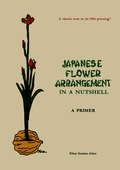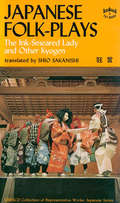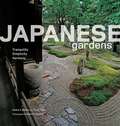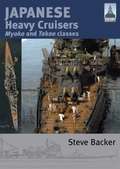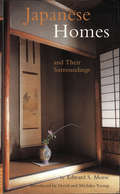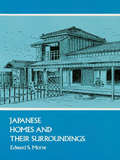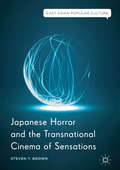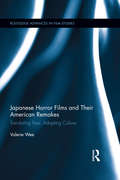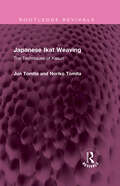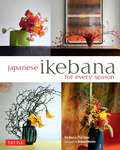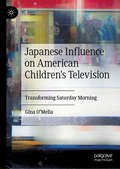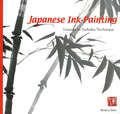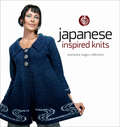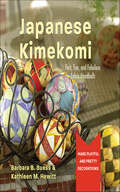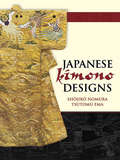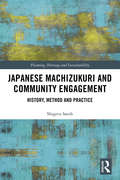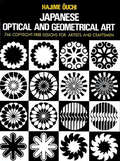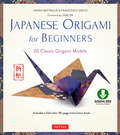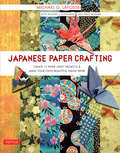- Table View
- List View
Japanese Flower Arrangement: A Primer
by Ellen Gordon AllenThis Japanese gardening book is a practical, concise guide to flower arranging or Ikebana.Illustrated with dozens of helpful photographs and diagrams, this flower arranging handbook provides full and comprehensive treatment of the various forms of Moribana and Heiki style arrangements. <P><P>Each lesson is given in detail step by step with accompanying sketches, showing clearly what should be done as the arrangement progresses towards completion. The photographs of actual completed flower arrangements sum up beautifully the principles underlying each particular style.The purpose of this text is to acquaint the reader with elementary knowledge in a special school of flower arranging-the Japanese school-selected because it is the oldest and its teachings are perhaps the simplest, yet most effective. The text is intended for amateurs, but professional arrangers might find it useful as a refresher.
Japanese Folk Plays: The Ink Smeared Lady and Other Kyogen
by Shio SakanishiThis collection of Japanese folk plays reveals a previously unknown and decidedly unaristocratic element to Japanese theater.<P><P>Interspersed between the stately, slower paced dramas of Japan's Noh theater are the delightful comic plays or interludes known as Kyogen. These brief plays evolved from the bawdy skits that were rousingly enjoyed by the plebeian populaces of the cities in feudal Japan some hundreds of years ago when Noh itself was a pastime and entertainment exclusively reserved for the aristocracy.Today they still provide delightful relief from the sustained and concentrated action of the Noh play that has changed very little throughout the centuries. Among the various forms of classical Japanese drama, the flamboyant action and brilliant coloring Kabuki has perhaps enabled it to be the most easily understood; and the Noh, in a number of excellent translations, has become widely known for its poetic beauty. But the Kyogen, equally deserving of attention, have remained relatively unknown. Only now, with this new edition of Miss Sakanishi's excellent translations, are they at last readily available to the Western reader.
Japanese Garden Design
by Marc P. Keane Haruzo OhashiThe creation of a Japanese garden combines respect for nature with adherence to simple principles of aesthetics and structure. In Japanese Garden Design, landscape architect Marc Peter Keane presents the history and development of the classical metaphors that underlie all Japanese gardens.Keane describes the influences of Confucian, Shinto and Buddhist principles that have linked poetry and philosophy to the tangible metaphor of the garden. Detailed explanations of basic design concepts identify and interpret the symbolism of various garden forms and demonstrate these principles in use today.
Japanese Gardens: Tranquility, Simplicity, Harmony
by Geeta K. Mehta Noboru Murata Kimie TadaFeaturing beautiful photographs and insightful commentary this Japanese gardening book is a must have for any gardening or zen enthusiast.At the heart of a Japanese garden is harmony with nature. <P><P>More than simply a landscape of trees and flowering shrubs, a Japanese garden provides a place of serenity and rest, filled with peaceful spots that lend themselves to meditation and contemplation. Japanese Gardens celebrates and illustrates this ideal, showcasing the exquisite natural beauty of more than 20 quintessentially Japanese gardens--big and small, urban and rural, traditional and contemporary.The expert author-and-photographer team behind this book excels at capturing and explaining the essential elements and techniques that distinguish Japanese garden design from that of other countries. The featured sites reflect a cross section of Japanese culture and history including large feudal period gardens, temple and Zen gardens and private countryside gardens. The mountain flower garden, tea garden, rock garden and bonsai garden alike are all celebrated and appreciated in this beautiful book.
Japanese Heavy Cruisers: Myoko and Takao Classes (ShipCraft #Vol. 5)
by Steve BackerThe ShipCraft series provides in-depth information about building and modifying model kits of famous warship types. Lavishly illustrated, each book takes the modeller through a brief history of the subject class, highlighting differences between sister-ships and changes in their appearance over their careers. This includes paint schemes and camouflage, featuring colour profiles and highly-detailed line drawings and scale plans. The modelling section reviews the strengths and weaknesses of available kits, lists commercial accessory sets for super-detailing of the ships, and provides hints on modifying and improving the basic kit. This is followed by an extensive photographic gallery of selected high-quality models in a variety of scales, and the book concludes with a section on research references books, monographs, large-scale plans and relevant websites.rnrnThis volume is devoted to the largest cruisers in the Imperial Japanese Navy. Built in defiance of treaty restrictions, they were the fastest and most powerful heavy cruisers of their day, and were heavily engaged in every campaign from Pearl Harbor to the end of the Pacific War.
Japanese Homes and Their Surroundings
by Edward MorseA classic text, Japanese Homes and Their Surroundings was originally published in 1886 by Edward S. Morse, a groundbreaking and imaginative inventor. Still considered an authoritative review of traditional Japanese architecture and landscape design, Japanese Homes and Their Surroundings contains over 300 detailed illustrations and reveals important historical and cultural sources, making it a time-tested resource for architects and landscape designers.
Japanese Homes and Their Surroundings (Dover Architecture)
by Edward S. MorseIn this book the author writes about the more than 4 years he spent visiting hundreds of Japanese homes and learning as much as possible about their construction, design, furnishings, and relative merits. It is the only authentic record of the traditional home -- mats, lamps, screens, gardens -- from its general plan to the smallest decorative detail. 307 illustrations.
Japanese Horror and the Transnational Cinema of Sensations (East Asian Popular Culture)
by Steven T. BrownJapanese Horror and the Transnational Cinema of Sensations undertakes a critical reassessment of Japanese horror cinema by attending to its intermediality and transnational hybridity in relation to world horror cinema. Neither a conventional film history nor a thematic survey of Japanese horror cinema, this study offers a transnational analysis of selected films from new angles that shed light on previously ignored aspects of the genre, including sound design, framing techniques, and lighting, as well as the slow attack and long release times of J-horror’s slow-burn style, which have contributed significantly to the development of its dread-filled cinema of sensations.
Japanese Horror Films and their American Remakes: Japanese Horror Films And Their American Remakes (Routledge Advances in Film Studies)
by Valerie WeeThe Ring (2002)—Hollywood’s remake of the Japanese cult success Ringu (1998)—marked the beginning of a significant trend in the late 1990s and early 2000s of American adaptations of Asian horror films. This book explores this complex process of adaptation, paying particular attention to the various transformations that occur when texts cross cultural boundaries. Through close readings of a range of Japanese horror films and their Hollywood remakes, this study addresses the social, cultural, aesthetic and generic features of each national cinema’s approach to and representation of horror, within the subgenre of the ghost story, tracing convergences and divergences in the films’ narrative trajectories, aesthetic style, thematic focus and ideological content. In comparing contemporary Japanese horror films with their American adaptations, this book advances existing studies of both the Japanese and American cinematic traditions, by: illustrating the ways in which each tradition responds to developments in its social, cultural and ideological milieu; and, examining Japanese horror films and their American remakes through a lens that highlights cross-cultural exchange and bilateral influence. The book will be of interest to scholars of film, media, and cultural studies.
Japanese Ikat Weaving: The Techniques of Kasuri (Routledge Revivals)
by Jun Tomita Noriko TomitaFirst Published in 1982, Japanese Ikat Weaving offers a professional approach to the subject, presented with great clarity and precision. Japanese Ikat weaving, also known as Kasuri, is the technique by which lengths of yarn are tied and dyed before weaving. Patterns created with this technique are unique and its popularity is increasing among weavers, craftsmen and textile designers in all parts of the world. The authors give an account of the history of Kasuri and describes the regional technical differences of its use in Japan. They deal in detail with the actual techniques of various types of weft and warp Kasuri; each sequence is explained clearly and concisely, using many diagrams. Kasuri and indigo are inseparable in Japanese Ikat weaving and the final section is therefore devoted to a discussion of indigo dyeing. This is an interesting read for students of textile design, fashion design and Japanese culture.
Japanese Ikebana for Every Season
by Rie Imai Yuji Ueno Noboru MurataThe true meaning of Ikebana-the traditional Japanese art of flower arrangement-is the ability to take a few beautiful flowers and plans and tastefully present them in very simple containers to decorate your home. Whether for Mother's Day, Valentine's Day, or a special birthday or anniversary-Japanese Ikebana for Every Season simplifies and demystifies this ancient art by presenting 53 elegantly simple arrangements that anyone can create at anytime at home.The key to good Ikebana arrangements is to understand a few very simple principles-like the idea of mitate-seeing old things with new eyes, as well as learning a few very easy techniques of flower stabilization and how to support plants and flowers inside a vase or container. Using simple, common flowers and plants from your garden, from a nearby field or forest, or from your local florist-you can easily create these lovely Ikebana in just a few minutes if you know how.Authors Rie Imai and Yuji Ueno explain how to select the flowers and the containers by simply using things that are already around you-and then they show you how to turn them into something special. The basic instructions in the book cover a wide range of styles that encourage readers to use their own creativity rather than copying traditional and highly technical Ikebana design concepts.No matter what time of year it is and regardless of your taste or budget-the arrangements in this book will lend a touch of Japanese elegance to your home!
Japanese Ikebana for Every Season
by Noboru Murata Yuji Ueno Rie ImaiThe true meaning of Ikebana-the traditional Japanese art of flower arrangement-is the ability to take a few beautiful flowers and plans and tastefully present them in very simple containers to decorate your home. Whether for Mother's Day, Valentine's Day, or a special birthday or anniversary-Japanese Ikebana for Every Season simplifies and demystifies this ancient art by presenting 53 elegantly simple arrangements that anyone can create at anytime at home.The key to good Ikebana arrangements is to understand a few very simple principles-like the idea of mitate-seeing old things with new eyes, as well as learning a few very easy techniques of flower stabilization and how to support plants and flowers inside a vase or container. Using simple, common flowers and plants from your garden, from a nearby field or forest, or from your local florist-you can easily create these lovely Ikebana in just a few minutes if you know how.Authors Rie Imai and Yuji Ueno explain how to select the flowers and the containers by simply using things that are already around you-and then they show you how to turn them into something special. The basic instructions in the book cover a wide range of styles that encourage readers to use their own creativity rather than copying traditional and highly technical Ikebana design concepts.No matter what time of year it is and regardless of your taste or budget-the arrangements in this book will lend a touch of Japanese elegance to your home!
Japanese Influence on American Children's Television: Transforming Saturday Morning
by Gina O’MeliaJapanese Influence on American Children’s Television examines the gradual, yet dramatic, transformation of Saturday morning children’s programming from being rooted in American traditions and popular culture to reflecting Japanese popular culture. In this modern era of globalization and global media/cultural convergence, the book brings to light an often overlooked phenomenon of the gradual integration of narrative and character conventions borrowed from Japanese storytelling into American children’s media. The book begins with a brief history of Saturday morning in the United States from its earliest years, and the interaction between American and Japanese popular media during this time period. It then moves onto reviewing the dramatic shift that occurred within the Saturday morning block through both an overview of the transitional decades as well as an in-depth analysis of the transformative ascent of the shows Mighty Morphin Power Rangers, Pokémon, and Yu-Gi-Oh!.
Japanese Ink Painting
by Ryukyu SaitoHere is a book to teach the beginner the fundamental techniques of suiboku, the unique form of Oriental art that has produced some of the world's finest masterpieces of ink-painting. Originating in China and having its spiritual basis in Zen Buddhism, this form of expressing nature's colors through shades of black ink monochrome has been enjoyed throughout the centuries in the Orient as a hobby for the amateur.
Japanese Ink Painting
by Ryukyu SaitoHere is a book to teach the beginner the fundamental techniques of suiboku, the unique form of Oriental art that has produced some of the world's finest masterpieces of ink-painting. Originating in China and having its spiritual basis in Zen Buddhism, this form of expressing nature's colors through shades of black ink monochrome has been enjoyed throughout the centuries in the Orient as a hobby for the amateur.
Japanese Ink Painting
by Ryukyu SaitoHere is a book to teach the beginner the fundamental techniques of suiboku, the unique form of Oriental art that has produced some of the world's finest masterpieces of ink-painting. Originating in China and having its spiritual basis in Zen Buddhism, this form of expressing nature's colors through shades of black ink monochrome has been enjoyed throughout the centuries in the Orient as a hobby for the amateur.
Japanese Inspired Knits: Marianne Isager Collection
by Marianne IsagerInspired by the seasonal festivals and traditions of Japan, this blend of traditional Scandinavian knitting with distinctive Japanese influences explores the beautiful design elements steeped in folk customs. Created especially for women, these patterns are true to the Japanese ideals of high-quality design and materials. Twelve sweaters, oriented around the months of the year, are each knitted using nearly a dozen different techniques. With project names like "Sake and Soba," "Summer in Tokyo," "Rice Fields," "Flower Buds," and "Stone Garden," knitters will have plenty of inspiration. In addition to standard knit and purl combinations, the patterns feature double knitting, domino knitting, shadow knitting, lace, cables, entrelac, intarsia, and stranded two-color knitting. All techniques are described in detail with clear text and illustrations, and an illustrated glossary at the end of the book provides technical instruction needed for any project. Also included are Japanese ideographs that relate to themes that inspired the projects, a Japanese calendar, plus lush travel photography of Japan that will inspire any knitter.
Japanese Kimekomi: Fast, Fun, and Fabulous Fabric Handballs
by Barbara B. Suess Kathleen M. HewittThe fun and easy Japanese craft of Kimekomi (pronounced kee-may-ko-mee)—the making of decorative fabric balls—dates back to the early 1700s with the making of cloth-covered wooden dolls. Today it has evolved into the artful covering of balls with cloth and ribbon and cord. In Japanese Kimekomi: Fast, Fun, and Fabulous Fabric Handballs authors Barbara Suess and Kathleen Hewitt have collected 16 colorful designs that are fun and easy to make. The book includes step-by-step drawings and color photos, full-size cutting templates, and easy-to-follow directions. The art requires no sewing skills, just some fabric, styrofoam balls, and a couple of hours. Begin with making simple but beautiful handballs and progress with the authors to creating new, unique designs. Nothing could be more charming as a gift, Christmas or Easter ornament, or party tokens.
Japanese Kimono Designs
by Shôjirô Nomura Tsutomu EmaJapan's ancient and esteemed tradition of textile arts has long been reflected in the delicate beauty of the kimono and its appealing designs. This unique design treasury, consisting of lavish full-color pictures of a vibrant array of kimonos, is reproduced directly from two rare and costly original portfolios.Devotees of fashion, art, and Asian culture will appreciate this beautiful book and its tribute to the elegance and refinement of Japanese art, as expressed in the colorful grace of kimono designs.
Japanese Love Hotels: A Cultural History (Routledge Contemporary Japan Series #Vol. 15)
by Sarah ChaplinDrawing on theories of place, consumption and identity, Sarah Chaplin details the evolution of the love hotel in urban Japan since the 1950s. Love hotels emerged in the late 1950s following a ban of licensed prostitution, then were extremely popular in the 1970s, were then legislated against in the 1980s and are now perceived as ‘leisure’, ‘fashion’ or ‘boutique’ hotels. Representing a timely opportunity to capture and evaluate the dying manifestations of an important era in Japanese social and cultural history, this book provides a critical account of the love hotel as a unique typology. It considers its spatial, aesthetic, semiotic, and locational denotations and connotations, which results in a richly nuanced cultural reading. The love hotel is presented as a key indicator of social and cultural change in post-war Japan, and as such this book will be of interest to a wide and international readership including students of Japanese culture, society and architecture.
Japanese Machizukuri and Community Engagement: History, Method and Practice (Planning, Heritage and Sustainability)
by Shigeru SatohOver the past few decades, Japan has faced severe earthquake disasters, an increasing aging population, declining birth rates, and widening social disparities. These issues have served to highlight gaps left by top-down governance approaches and the urgent need to create resilient societies using more traditional models. Japanese “machizukuri” has developed to become an exceptional example of bottom-up creative approaches based on collective action and use of local resources. Since its evolution in the 1960s, machizukuri has come to define diverse and creative community-driven management models, by which local communities are enabled to actively tackle problem-solving. Including contributions from experts directly engaged in the process, this book explores the original development of machizukuri in Japan, its diffusion through East Asia and the positive outcomes of this transfer. Combining theoretical explanations with practical case studies, from pre-disaster planning in Tokyo, to the revitalization of historic towns and rural areas around Japan, the book looks at specific solutions, tools, and links between academics, communities, organizations, governmental bodies, and the private sector. It will appeal to researchers in planning, community engagement, architecture, urban design, and sustainable development.
Japanese No Masks: With 300 Illustrations of Authentic Historical Examples
by Stanley Appelbaum Friedrich PerzynskiCombining elements of dance, drama, music and poetry, the performances of Japanese No theater are a highly stylized form of entertainment. Accompanying the sumptuous costumes worn during performances are elaborately carved No and Kyogen wooden masks--major works of art in their own right. This book, based on a classic two-volume German study, presents a wealth of illustrations and information relating to these magnificent theatrical devices.A new, informative introduction and extensive captions derived from the original text and newly translated, accompany the heart of the book--more than 120 full-page plates depicting museum-quality masks worn by actors playing gods, warriors, demons, and monsters, beautiful women, feudal lords, mad characters, and supernatural beings. All 303 illustrations from the original two-volume work are included.A unique introduction to classic Japanese theater for Western theatergoers, this volume will also serve as an excellent reference for students, scholars, and enthusiasts of No drama.
Japanese Optical and Geometrical Art (Dover Pictorial Archive)
by Hajime OuchiSome of the most ingenious and attractive modern motifs. 746 designs.
Japanese Origami for Beginners Kit
by Vanda Battaglia Francesco DecioMake simple and fun paper craft models with this easy origami book and paper kit. The ancient art of origami originated in Japan, where it is steeped in traditional values. The 20 models presented in this kit include many with strong symbolic meanings, such as the carp, the frog and the crane, which symbolize longevity, good luck and perseverance. Also included in this kit are paper models which have practical uses, such as a bag in which to store spices or powdered medications, the masu box for containing small gifts, and uniquely shaped notes with elaborate closures. The more playful side of origami is represented as well: the stylized sumo wrestler with realistic moves has entertained Japanese children for centuries, and the paper Samurai hat is fun to play with. Origami is an ideal activity for children since paper folding develops dexterity and creativity. Origami is also a craft based on a few fundamental 3D folding techniques, soJapanese Origami for Beginners Kit is a useful starting point for fans of all ages and abilities. Although this book is aimed at origami beginners, it contains projects suitable for origami fans of all ages and abilities and is the perfect book for all those who enjoy making things with their hands. This book opens with an illustrated history of origami that highlights the masters and evolution of this pastime and art form up until the present day. A glossary of important origami folding symbols shows you how to follow the diagrams, which are commonly used to indicate how to fold origami models. Easy-to-follow step-by-step instructions follow for each of the 20 models. For those who prefer to see the models folded, this kit includes complete video instructions on a free DVD. It also has72 high-quality origami folding papers, all decorated with a wide selection of traditional Japanese designs and patterns. All of the folds are simple enough to be origami-for-kids projects and are a great way to learn origami. None of the projects require paint or glue; so just grab the included origami paper and start folding right away!
Japanese Paper Crafting
by Richard L. Alexander Michael G. Lafosse Greg MudarriAcross the country interest in paper crafts is booming. People from all walks of life are creating scrapbooks, making gift cards and learning origami. Washi, a traditional handmade paper originating in Japan, is a perfect accompaniment to these crafts. Japanese Paper Crafting teaches the essentials of making beautiful and unusual washi paper at home.Using diagrams and photographs, this book's step-by-step instructions will show both novice and experienced paper artists how to make washi paper and how to create 17 exciting washi projects with their own handmade paper! Projects include a hand-bound blank book; purses and wallets; desktop and tabletop accessories.
